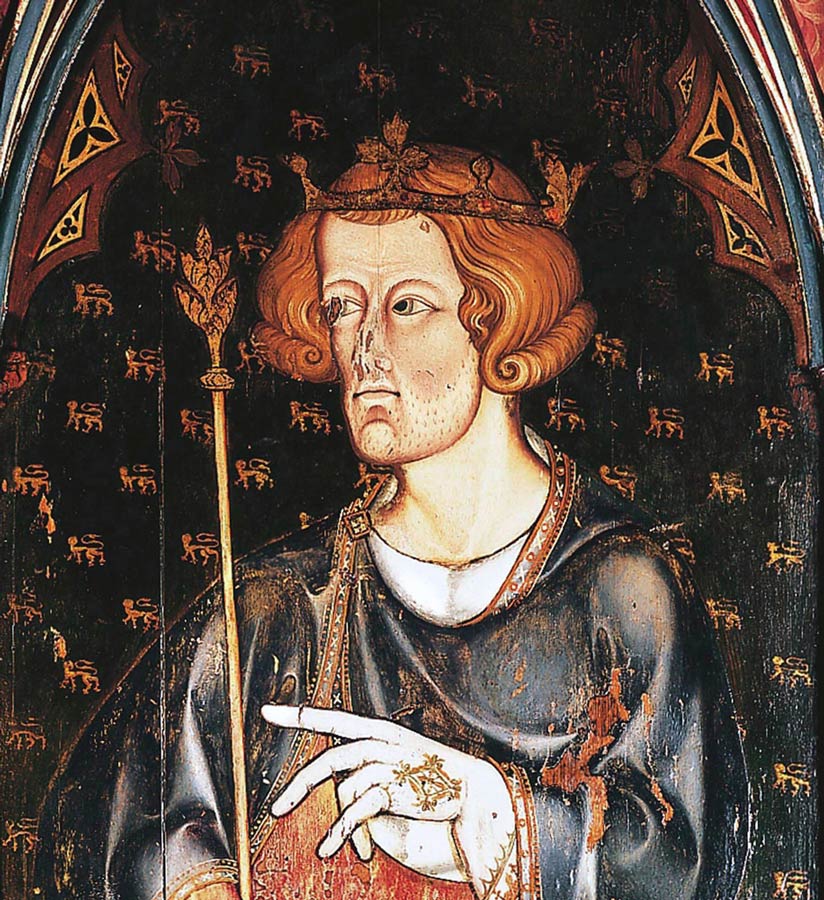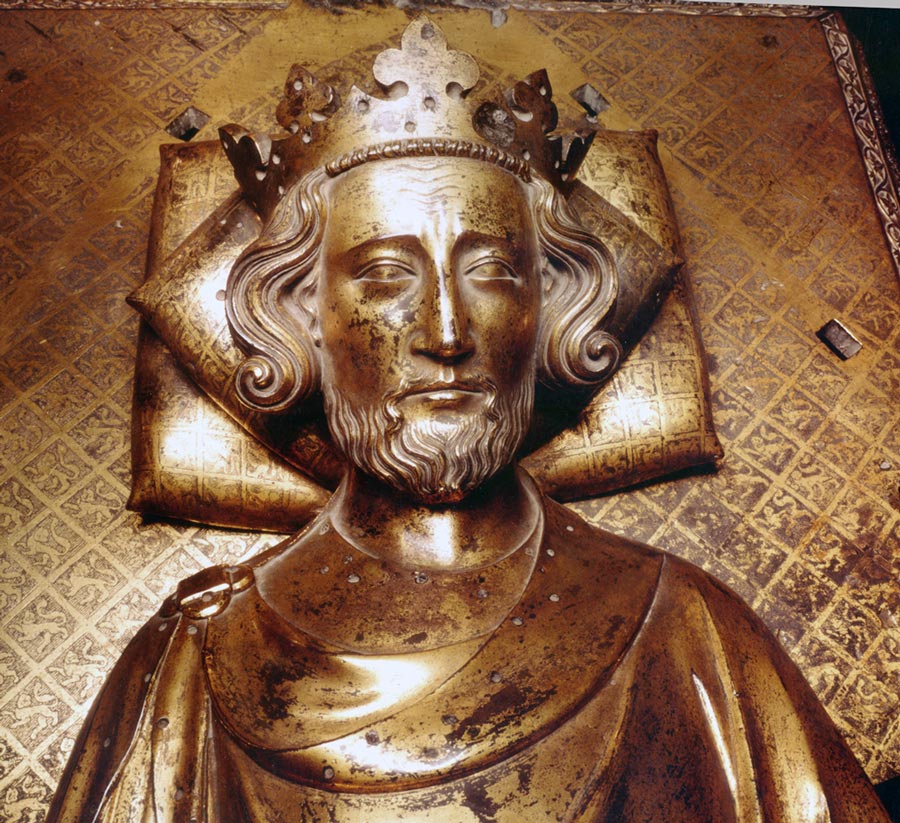Edward I and Eleanor of Castile
Edward was born in the Palace of Westminster on 17th June 1239, the eldest child of Henry III and Eleanor of Provence, and was baptised in the Abbey. His nickname was "Longshanks", being 6 feet 2 inches tall, and he is chiefly remembered for his battles against the Welsh and the Scots and for his legal reforms. In 1296 he brought to the Abbey the Stone of Scone, on which Scottish kings had once been crowned, and made a special oak Coronation Chair to enclose it. The Stone was returned to Scotland in 1996 and is displayed in Edinburgh Castle.
Marriage and children
In October 1254 aged just 15, he married Eleanor (Leonor), daughter of Ferdinand III, King of Castile and Leon, at Las Huelgas. It was a love match and the couple were inseparable until her death. They had four sons, including Edward II, and eleven daughters. Many of these died young, of whom John, Henry, Alphonso, Joan and Berengaria, were buried in the Abbey. It is thought that John (died 1271 aged 5) and Henry (died 1274 aged 6) are buried in the tomb now in the south ambulatory (near St Benedict's chapel) which was originally free-standing. This has Cosmati work decoration on the top and was probably moved from St Edward's chapel when the chantry for Henry V was erected there. John is known to have been buried in this chapel on 8th August. The Abbey master mason received payments for the workmen employed on John's tomb in 1273.
Also buried in the Abbey is his daughter Eleanor, Countess of Bar (1264-1298), who was married to Henri III, Count of Bar but she has no marker. Her children were Edward and Joan (who married John de Warenne, Earl of Surrey), and possibly Eleanor.
Joan of Acre (the second Joan in the family) married Gilbert de Clare in the Abbey in 1290. Margaret married the Duke of Brabant, Mary became a nun at Amesbury, and Elizabeth married secondly Humphrey de Bohun. Julian, Alice, Beatrice and Blanche were the other daughters who died young.
Edward's second wife was Margaret (died 1318), daughter of Philip III, King of France, and they were married at Canterbury cathedral in 1299. They had three children - Thomas (Brotherton), Earl of Norfolk, Edmund, Earl of Kent and Eleanor who died young. She was buried at Christ Church Greyfriars in London.
Coronation
Edward was on his way home from a Crusade when he heard of his father's death in 1272 but he did not hurry back and his coronation, with Eleanor, in the Abbey did not take place until 19th August 1274.
Burial
Edward died on 7th July 1307 at Burgh on the Sands in Cumberland and his embalmed body was taken first to Waltham Abbey in Essex before being brought to Westminster for burial in the chapel of St Edward the Confessor on 27th October. His large grey marble tomb chest, in which his bones lie, has no effigy or decoration and the, now rather faint, inscription was not painted on it until the 16th century:
Edwardus Primus Scotorum Malleus. Pactum Serva
[Edward the First, Hammer of the Scots. Keep Troth]
In 1774 his tomb was opened and inside a Purbeck marble coffin his body was found nearly entire, wrapped in a waxed linen cloth and wearing royal robes of red and gold with a crimson mantle. He had a gilt crown on his head and carried a sceptre surmounted by a dove and oak leaves in enamels.
A painted figure, which may represent him, is on the wooden Sedilia in the Abbey, to the south of the High Altar.
Eleanor of Castile
She was born about 1241 and died at Harby in Nottinghamshire in November 1290. Her body was embalmed and Edward erected stone memorial crosses at the places where her funeral procession rested on its way back to London, from Lincoln to Charing Cross. Her heart was laid at Blackfriars but the monument there was destroyed at the Dissolution of the monastery. A monument for her at Lincoln was destroyed in 1641 (this was nearly identical to the one at Westminster).
She has a fine tomb in St Edward the Confessor's chapel at Westminster Abbey, by Richard Crundale, with a gilt bronze effigy cast by goldsmith William Torel in 1291. She holds the string of her cloak in one hand but the sceptre in her other hand has now gone. It resembles the representation of her on her seal. The tomb slab and pillows beneath her head are covered with the emblems of Castile and Leon (castles and lions).
On the ambulatory side is a carved iron grille of exquisite workmanship by Thomas of Leighton Buzzard. On the base of the tomb are remains of a painting showing outlines of figures including four pilgrims praying and a knight, Sir Otes de Grandison, Lord of Grandson (c.1238-1328), kneeling before the Virgin and Child. He is identified by his armorial surcoat. Sir Otes was a close friend of Edward and accompanied him to the Holy Land (his tomb is in Lausanne cathedral, Switzerland). This painting may be by Master Walter of Durham. The original wooden canopy to the tomb has gone and the present one is in the Perpendicular style.
The Norman-French inscription can be translated as
Here lies Eleanor, sometime Queen of England, wife of King Edward son of King Henry, and daughter of the King of Spain and Countess of Ponthieu, on whose soul God in His pity have mercy. Amen.
Tomb dimensions in metres: length 3.02. width 1.10. height 1.65.
Seal bag
In the Abbey archives is a document of AD.1280 to which is attached an embroidered seal bag depicting the Royal Arms of England. This is the only example so far known of wool inlaid work surviving from medieval England. This can be viewed in the Queen's Diamond Jubilee Galleries.
Further reading
Queens Consort of Westminster Abbey
Edward I by Michael Prestwich, 1997
An account of the body of King Edward the First…on opening his tomb…in 1774 by Sir Joseph Ayloffe, 1775. Sketches of the body by William Blake are at the Society of Antiquaries in London.
Oxford Dictionary of National Biography 2004
Eleanor of Castile by Jean Powrie, 1990
Eleanor of Castile, Essays to commemorate the 700th anniversary of her death, edited by David Parsons, 1991 (including the Crosses and tomb)
Royal tombs of medieval England by Mark Duffy, 2003
The History of the King's Works vol.1 ed. H.M. Colvin 1963 (chapter XI - Royal tombs and monuments 1066-1485)
A Master Smith of the Middle Ages – Thomas of Leighton by Jane Geddes, Country Life August 1975
The polychromy at Westminster Abbey by Marie Louise Sauerberg in BAA Conference transactions "Westminster, the art....of the Royal Abbey", 2015
Medieval paintings at Westminster by W.R. Lethaby (about the Grandison painting), Proceedings of the British Academy 1927.
The Cosmatesque mosaics of Westminster Abbey, vol.2 The royal tombs by W.Rodwell and D.Neal, 2019 (for tomb of young John and Henry).
Two royal seal bags from Westminster Abbey by Frances Pritchard in Textile History, 1989

This image can be purchased from Westminster Abbey Library
Image © 2024 Dean and Chapter of Westminster

This image can be purchased from Westminster Abbey Library
Image © 2024 Dean and Chapter of Westminster

This image can be purchased from Westminster Abbey Library
Image © 2024 Dean and Chapter of Westminster

This image can be purchased from Westminster Abbey Library
Image © 2024 Dean and Chapter of Westminster

This image can be purchased from Westminster Abbey Library
Image © 2024 Dean and Chapter of Westminster

This image can be purchased from Westminster Abbey Library
Image © 2024 Dean and Chapter of Westminster

This image can be purchased from Westminster Abbey Library
Image © 2024 Dean and Chapter of Westminster

This image can be purchased from Westminster Abbey Library
Image © 2024 Dean and Chapter of Westminster

This image can be purchased from Westminster Abbey Library
Image © 2024 Dean and Chapter of Westminster










